Physical Address
304 North Cardinal St.
Dorchester Center, MA 02124
Colitis encompasses a spectrum of infectious and noninfectious inflammatory conditions. Infectious colitides, with etiologies often overlapping with enteritis (see Chapter 104 ), are typically acute in onset and may be localized as in acute appendicitis. The causative agent may not be known in inflammatory colitis. Some patients with hemolytic uremic syndrome (HUS) or inflammatory bowel disease (IBD) are recognized as having altered immune regulation, and more often this form of colitis is chronic. Etiologies, clinical manifestations, imaging, and treatment options of these colitides, and others including treatment-related colitis (e.g., pseudomembranous and radiation-induced colitis), will be discussed. For some, such as IBD, this will be expanding on the discussion from Chapter 104 .
IBD includes Crohn disease (CD), ulcerative colitis (UC), and unclassified IBD. For the incidence, etiology, pathophysiology, and clinical presentation of IBD in the pediatric population, including very early onset IBD, please refer to Chapter 104 . In this chapter, we will be addressing imaging of CD and UC, including perianal disease, and treatment where it differs from IBD of the upper gastrointestinal (GI) tract.
A summary of the diagnostic performance of various modalities in diagnosing features of IBD is listed in Table 106.1 .
| US Sens./Spec. |
CT ^ Sens./Spec. |
MRI ^ Sens./Spec. |
|
|---|---|---|---|
| Crohn colitis | 63%-100% / 77%-100% | 60%-90% / 90%-100% | 78%-100% / 46%-100% # (60% / 90%) |
| Ulcerative colitis | 48%-100% / 82%-90% | 74% / N/A | 59%-68% / 32%-40% |
| Fistula | 71%-87% / 90%-100% | 68% / 91% | 71%-100% / 92%-100% |
| Abscess | 81%-100% / 92%-94% | 86%-100% / 95%-100% | 75%-86% / 91%-93% |
| Stenosis | 100% / 90% | N/A | 75%-100% / 91%-100% |
* Summary of “Imaging techniques for assessment of inflammatory bowel disease: Joint ECCO and ESGAR evidence-based consensus guidelines” —not specific to pediatrics
# “Detecting inflammation in the unprepared pediatric colon – how reliable is magnetic resonance enterography?”—pediatric
^ technique, e.g., enterography, colonography, not always specified
Radiography has an emergent role in IBD and, while not routinely used, familiarity with more reliable features of IBD remains important including “thumbprinting.” Of importance in UC and ileocolonic CD is toxic megacolon, with colonic dilatation seen on abdominal radiographs. Dilatation of the transverse colon exceeding 56 mm in patients greater than 11 years (normal rarely >40 mm in younger patients) is a strong indicator of toxic megacolon, particularly if seen in conjunction with three of four criteria: fever, tachycardia, leukocytosis, or anemia ( Fig. 106.1 ).
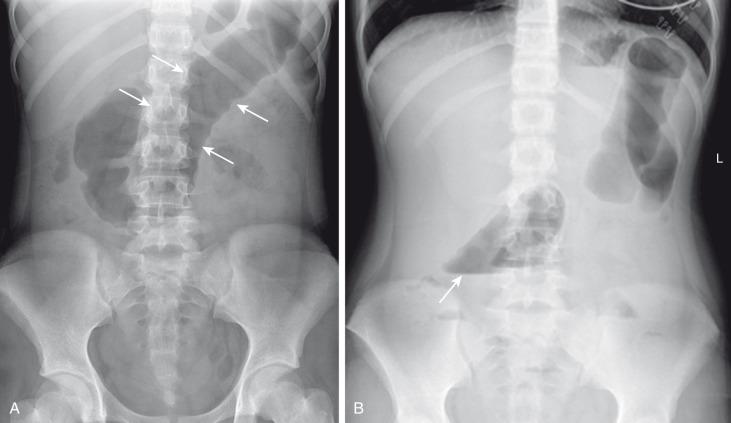
As discussed in Chapter 104 , abdominal and pelvic ultrasound (US) now plays an important role in pediatric IBD, for monitoring disease, diagnosis if magnetic resonance imaging (MRI) is not an option, and problem solving in acute situations by demonstrating abscesses, stenoses, fistulae or an acute flare, with advantages and limitations as previously considered. US after ingestion of nonabsorbable oral contrast can assist if colonic strictures render ileocolonoscopy nondiagnostic. Good specificity but lower sensitivity of conventional US is primarily due to differences in detection of colonic inflammation by location, limiting its usefulness as a screening tool. US accuracy is high in a majority of the large bowel but lower in the transverse colon and rectum.
Mural and extramural features in colonic CD emulate small bowel findings (see Chapter 104 ). Crohn colitis can have skip lesions or be right side only ( e-Fig. 106.2 ). In comparison, UC is characterized by continuous involvement of the colon from the rectum progressing retrograde with intermediate wall thickening, slightly hypoechoic and nonhomogenous mucosa, and submucosal edema (acute phase) with preserved mural stratification. Chronic UC can have submucosal fibrosis ± fat deposits, loss of haustrations, and stiffness. Even so, distinction from Crohn colitis is poor ( Fig. 106.3 ). Pancolitis can be associated with backwash ileitis (6%–20%). Transmural involvement is rare in UC, as are extramural findings. Regional variations with macroscopic rectal sparing and cecal patches are not usually evident on cross-sectional imaging.
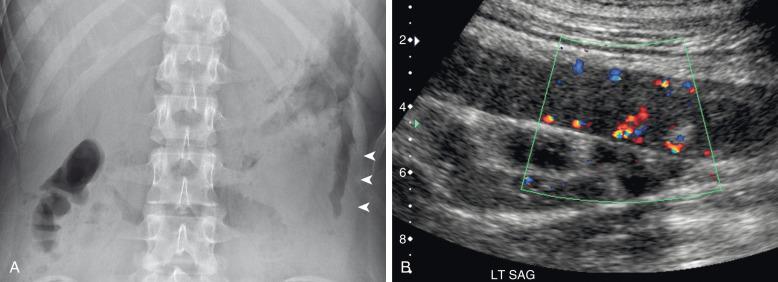
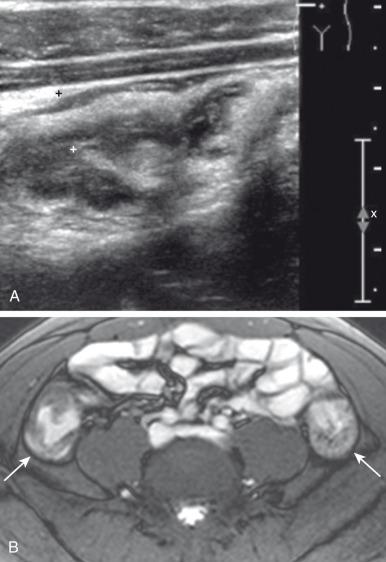
Perianal and perineal US have a small role in the acute setting to rapidly identify a perianal abscess that may require urgent drainage. A percutaneous approach can demonstrate fistulae, although with variable accuracy, and classification largely depends on use of endoanal probes that are seldom utilized in children and adolescents.
Single or double contrast enemas are now rarely used in IBD imaging due to the ionizing radiation and inability to evaluate transmural and extramural features. Infants and young children may still benefit from this technique for diagnosis and documenting extent of very early onset IBD ( e-Fig. 106.4 ). Water-soluble contrast agents are now often used in preference to barium. Mucosal ulceration, pseudopolyps, loss of haustrations, stenoses, and fistulae have all been documented in CD. Enteroenteric fistulae may be demonstrated to lesser extent with fluoroscopy than with other techniques. UC typically has shallower ulcers, with less wall deformity and stricturing.
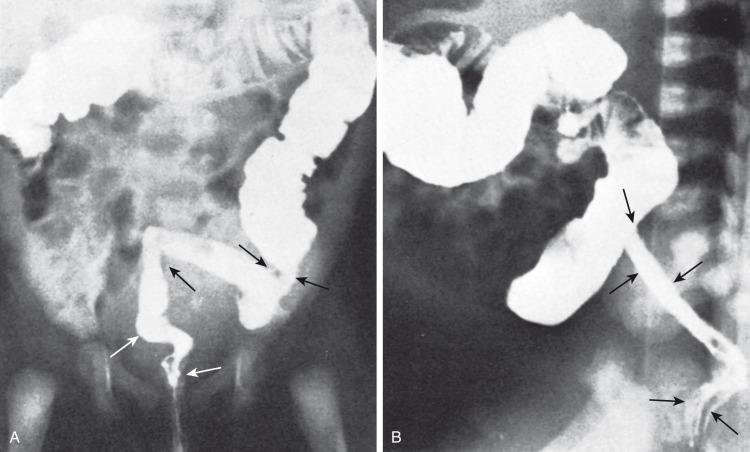
The colon is evaluated when included in computed tomographic enterography (CT) and magnetic resonance enterography (MRE) assessment of small bowel, without any special colonic preparation. CD features are similar to that seen in small bowel (see Chapter 104 ) with deep ulcers, pseudopolyps, mural thickening and hyperenhancement, engorged vasa recta, and on MRE, T2 hyperintensity and restricted diffusion. In UC, mural thickening can be subtler with preservation of the smooth outer contour of the bowel wall ( Fig. 106.5 ). As with US, MRI can occasionally demonstrate mural fat in chronic UC, although infrequently seen in children ( e-Fig. 106.6 ). In both, loss of colonic haustrations can be seen (“lead pipe” configuration). In Crohn colitis in particular, extramural changes can include fibrofatty proliferation, mesenteric enhancement, or edema, abscesses, and fistulae. Although strictures can be difficult to appreciate in collapsed large bowel, this was not an impediment to detection of colonic inflammation, with a recent small study comparing MRE with endoscopic biopsies showing a sensitivity of 90% and specificity of 60% for active inflammation ( Fig. 106.7 ). Unsuspected perianal disease is increasingly recognized on MRE, and this region warrants careful review (see later in this chapter).
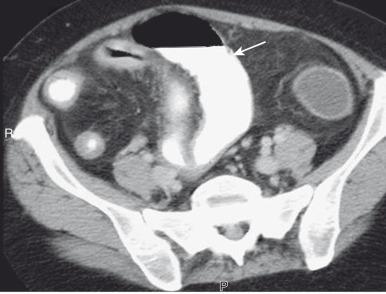
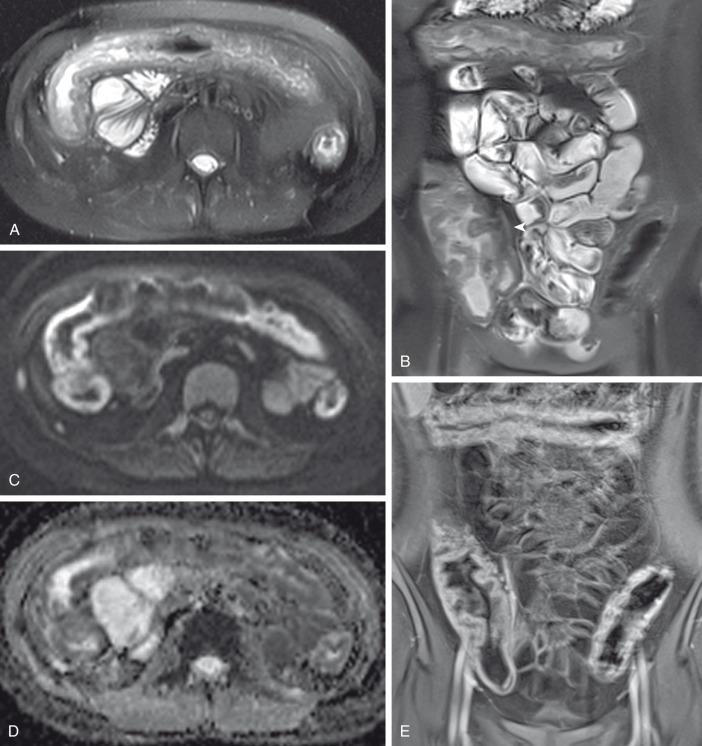
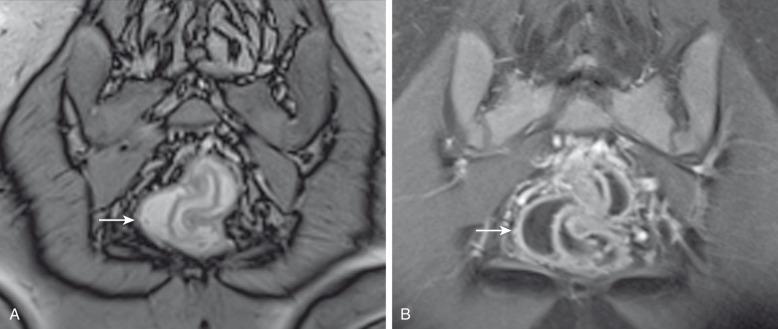
CT colonography (virtual colonoscopy) uses colonic air insufflation, and MR colonography uses rectal instillation of warm water or saline to distend the colon, although colonic IBD can be seen even without good distension ( e-Fig. 106.8 ). MR colonography, lacking ionizing radiation, may have value if ileocolonoscopy is incomplete due to strictures or patient contraindications. This provides mucosal, mural, as well extramural information, which in undifferentiated IBD can aid in distinguishing CD from UC. In pediatric IBD, patient tolerance precludes MR colonoscopy from being employed routinely in conjunction with MRE, although it is done in some centers. There are variable rates of detection reported for CD on MR colonography (which performs better for UC), such that ileocolonoscopy remains the mainstay of evaluation in pediatric IBD.
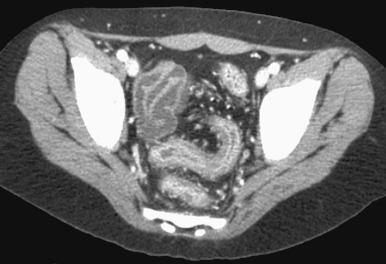
For perianal disease, occurring in up to 21% of pediatric CD patients, pelvic MRI is the imaging reference standard ( Fig. 106.9 ). Fistulae and abscesses are well depicted, and MRI is superior to US and examination under anesthesia, although accuracy is increased when these are combined. Skin tags can also be seen. Described according to Parks' or St. James University Hospital classifications, one review has suggested the Parks' classification is more suited to children due to shorter anal canal length, typically performed without an endoanal coil. Contrast-enhanced and diffusion-weighted imaging can help define disease activity as well as distinguishing fistulae from abscesses. Activity measures (e.g., Van Assche and predictors of treatment response) are increasingly used to guide therapy, with better responses seen with maximum fistula length less than 2.5 cm and abscess volume less than 1 mL. Contraindications for MRI and risks relating to iodinated and gadolinium-based contrast agents will be discussed elsewhere. There is seldom a role for CT in perianal disease in children.
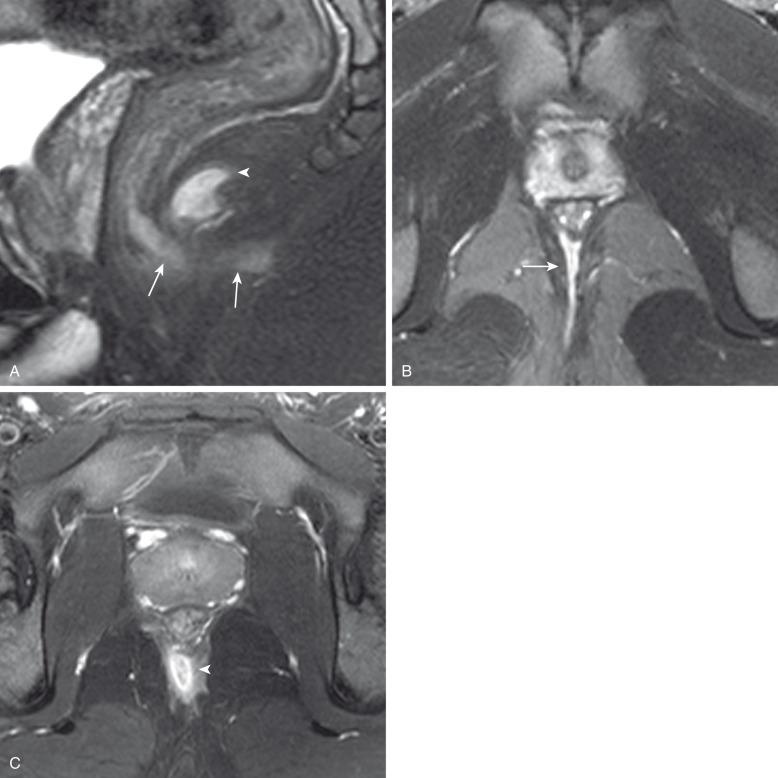
A negative scintigraphy study in CD (e.g., radiolabeled leucocytes or positron emission tomography (PET)/CT or PET/MR) can exclude active disease with high accuracy. While monitoring treatment response and distinction of inflammatory and fibrotic strictures is promising, as with small bowel (see Chapter 104 ), there is limited application for pediatric IBD due to the ionizing radiation and poor evaluation of perianal disease.
Toxic megacolon requires aggressive therapy combining medical and surgical approaches due to a high risk of perforation. Managing the underlying cause and supportive therapy with bowel rest, then enteral feeds, low-dose heparin for deep venous thrombosis prophylaxis, high-dose steroids, and antibiotics should not exceed 48 hours. Nasogastric suction is not beneficial. Subtotal colectomy and end ileostomy with a Hartmann's closure of the rectum, required in 47%, has a lower mortality rates than total colectomy, although emergent total colectomy is sometimes needed.
Medical treatment and surgical intervention in Crohn colitis is discussed in Chapter 104 . In UC, corticosteroids and 5-aminosalicylates are initially used to achieve and maintain mucosal healing. Antitumor necrosis α (anti-TNFα) therapies such as infliximab are reserved for persistently active UC in up to 20% of steroid-dependent patients. Colectomy rates vary geographically, approximating 15% at 5 years and 20% 10 years after presentation and, while curative, is not without morbidity.
Perianal fistulae and abscesses involve both medical and surgical options such as antibiotics, topical or systemic biologic agents, fistulotomy, fecal diversion, and primary incision and drainage. The choice depends on severity, activity, and prognostic features of fistula length and abscess volume. Anti-TNFα agents should be avoided with abscesses but in combination with seton drainage achieves a 90% response, although relapse rates are high.
Pseudomembranous colitis refers to severe colonic disease that occurs in approximately 15% to 25% of patients with antibiotic-associated diarrhea.
The toxins produced by the bacterium Clostridium difficile are the most important cause of antibiotic-associated pseudomembranous colitis, producing whitish, raised, plaquelike lesions restricted to the colon, as distinct from nonantibiotic-associated pseudomembranous colitis, which can also involve small bowel. Other less common toxins include those produced by C. perfringens and Staphylococcus aureus. The diagnosis is a combined clinical and laboratory one (enzyme immunoassay detection of toxin A and B in stool and higher sensitivity polymerase chain reaction toxin gene detection). Infants exposed to C. difficile do not become unwell due to inability of the toxin to bind to immature colonic mucosa, thus pseudomembranous colitis is more common in adults than in children and rare in infants. Recently, studies have shown an association of recurrent C. difficile colitis in older patients who had undergone remote appendectomy, suggesting a role of immune protection by the normal appendix.
Pseudomembranous colitis is characterized by fever, bloody diarrhea, cramping, and colonic mucositis and can be life-threatening. The condition most commonly follows broad-spectrum antibiotic therapy occurring in hospitalized patients who are often debilitated, immunocompromised, or recovering from surgery. However, it may occur without preceding antibiotic therapy in patients in whom the gut flora has been altered, such as after weaning or surgery. The onset of diarrhea may occur within weeks after cessation of antibiotic therapy.
Imaging is less specific than clinical and laboratory findings. On abdominal radiographs, findings of pseudomembranous colitis are similar to other colitides unless it is severe, with small bowel dilatation, “thumbprinting” in segments of variable length, haustral thickening and colon dilatation, and rarely gross cecal distension. Enemas should be avoided. US, MR, or CT findings of pancolitis, with or without ascites, can be seen. Bowel wall thickening on US is predominantly hypoechoic, and on CT and MR, occasionally nodular haustral thickening can be seen (the “accordion” pattern).
Preceding antibiotic therapy associated with the colitis should be stopped. The first line of antibiotic treatment is oral metronidazole and supportive measures including rehydration. Other oral or intravenous (IV) antibiotics may be needed initially and with recurrence; colectomy is now rarely indicated.
Hemolytic uremic syndrome (HUS) is a thrombotic, nonimmune, microangiopathic condition characterized by renal failure, hemolytic anemia, and thrombocytopenia. In children, it can be related to foods such as undercooked meat in 90% of cases, causing infection often with diarrhea. The syndrome has a peak incidence of approximately 6.1 per 100,000 in children aged less than 5 years.
Most cases of HUS are caused by a Shiga-like toxin produced by Escherichia coli serotype 0157:H7 (STEC-HUS). This is found in raw or incompletely cooked beef and unpasteurized dairy products. Rarely HUS can arise from severe disseminated Streptococcus pneumoniae (pneumococcal-HUS). When these infections are excluded, HUS is designated atypical (aHUS), usually without diarrhea, and dysregulation of the complement system is recognized as the pathogenic effector mechanism. Hemorrhagic colitis is common. Renal and central nervous system complications can markedly affect the course and prognosis of this disease; outcomes typically are more severe in aHUS.
STEC-HUS is most common during the summer months in children younger than 5 years of age. It has a spectrum of clinical manifestations from asymptomatic carrier, to a short GI prodrome averaging 3 days from ingestion with nonbloody diarrhea, to clinical evidence of acute renal failure, fever, anemia, and thrombocytopenia. A positive stool culture for the specific Shiga toxin–producing E. coli pathogen is definitive when positive. Pneumococcal-HUS may have respiratory and neurologic features in addition to the more severe HUS triad. aHUS occurs as a single event, more frequently progressing to a chronic condition.
In hemorrhagic colitis, US reveals concentric wall thickening, echogenic pericolonic fat, and narrowing of the bowel lumen, primarily affecting the cecum and ascending colon, although the small bowel may be affected. These features are nonspecific and may be seen in other infiltrative and inflammatory colitides. Radiographs may show colon “thumbprinting.” This is better seen on CT and MRI (which are rarely indicated), with contiguous bowel wall thickening, free fluid, and fat stranding. Radiographic IV contrast media should be avoided due to renal impairment. There is no role for fluoroscopy. Toxic megacolon and colonic perforation have been reported, and colonic strictures can occur as a late complication.
Initial treatment for HUS is supportive and may include IV fluids, transfusion of blood products, and management of hypertension. Supportive renal dialysis, if needed, is usually for 10 days in 40% to 50% with STEC-HUS, with recovery of renal function in 55% to 70% of cases. Patients with aHUS may need longer renal replacement support and have worse outcomes. Use of a monoclonal antibody ecluzimab, blocking the C5 cascade, is showing promising results in limiting duration of HUS in the acute phase and improving outcomes after transplantation, reducing HUS recurrence.
Secondary toxicity to the GI tract is a known complication of radiation therapy. The incidence of radiotherapy-related bowel toxicity is variable depending on the radiation port, radiation dose, dosing schedule, underlying bowel condition, and comorbidities. The presentation can be acute or chronic, and different mechanisms are responsible for each. The changes can occur months to years after exposure and may involve the small bowel, colon, or rectum.
Radiation injury leads to activation of mucosal cytokines and increased levels of inflammatory mediators such as interleukin (IL)-2, IL-6, and IL-8. The acute changes are attributed to inhibition of epithelial cell mitotic activity and thus denudation of the mucosal surface. The chronic changes are sequelae of progressive obliterative endarteritis and fibrosis that result in variable degrees of ischemia, necrosis, and eventually stricture and fistulae formations. Radiation enteritis tends to develop in patients who have received in the order of 45 Gy but can occur with doses as low as 5 to 12 Gy.
Diarrhea, cramping, and sometimes lower intestinal bleeding occur in the acute phase, which is usually self-limiting. Urgency and tenesmus can also be seen with radiation proctitis. Eventually, fibrosis may occur, which leads to stiffness and loss of mobility and distensibility of the affected portions of the colon. Additional complications include partial obstruction, chronic adhesions, and fragility of the bowel, which may culminate in perforation. Perianal fistula, hematochezia, and incontinence have been reported in patients receiving pelvic radiation.
Become a Clinical Tree membership for Full access and enjoy Unlimited articles
If you are a member. Log in here